
WEDNESDAY, July 15, 2015 (HealthDay News) — Alzheimer’s disease seems to develop differently in the brains of black patients than in whites. And, black people seem more likely to suffer different types of brain changes that also contribute to dementia, a new study reports.
Alzheimer’s disease dementia is generally associated with a build-up of substances known as plaques and tangles inside the brain. But, there are other brain changes that can also contribute to dementia, the study authors noted.
For example, the brains of people with dementia sometimes contain infarcts — tiny areas of dead tissue caused by micro-strokes, the researchers explained. They also might contain Lewy bodies — another form of abnormal protein build-up in the brain that’s usually associated with Parkinson’s disease.
Autopsies of black and white Alzheimer’s patients revealed that blacks were more likely than whites to experience a mix of dementia-related changes, as opposed to the damage usually associated with “pure” Alzheimer’s dementia, according to the study.
“We were surprised that the African Americans were much more likely to have a mixed picture,” said lead author Lisa Barnes, a professor of neurology and behavioral science at Rush University Medical Center in Chicago. “The underlying brain changes were different, which indicates that they probably had different risk factors.”
The study findings were published online July 15 in advance of print publication in the journal Neurology.
Dementia isn’t a specific disease, according to the Alzheimer’s Association. Instead, dementia refers to a wide range of symptoms, such as memory loss and communication problems, that are significant enough to interfere with daily life, the association explains.
The study found that among 81 white patients who died, 42 percent only displayed signs of typical Alzheimer’s disease. About 51 percent of them had a mix of brain changes that included infarcts and Lewy bodies, the researchers said.
But among 41 black patients who died, about 20 percent displayed only the usual Alzheimer’s plaques and tangles. Almost all the rest — more than 70 percent — experienced infarcts and Lewy bodies on top of the usual Alzheimer’s brain changes.
Blacks also had more frequent and severe blood vessel disease in their brains, such as hardening of the arteries, the investigators found.
These results could help begin to explain why blacks in the United States are twice as likely to develop Alzheimer’s than people of European descent, said Heather Snyder, director of medical and scientific operations for the Alzheimer’s Association.
Black people are more likely than whites to suffer from heart disease, high blood pressure and type 2 diabetes, all of which increase a person’s risk of infarct-causing strokes, Barnes said.
There also might be specific genetic differences that lead to increased risk of Lewy bodies and other dementia-related brain changes, Snyder suggested.
“This certainly warrants further investigation, to ask those types of questions,” Snyder said.
Researchers were careful to match the patients, making sure that all suffered from similar levels of Alzheimer’s disability prior to death, Barnes said. After death, autopsies revealed that nearly all of the participants had experienced some brain changes related to either Alzheimer’s or dementia.
Learning the differences between black and white Alzheimer’s patients will be critically important to researchers who hope to find treatments and cures for dementia, said Dr. Ezriel Kornel, assistant clinical professor of neurosurgery at Weill Cornell Medical College in New York City.
“It will help to more readily treat individuals who have dementia, by understanding what the cause is,” Kornel said. “As we come closer to finding answers to what the causes and cures of Alzheimer’s are, those answers might be effective for [whites] but not effective for the black population. You have to look at more than just Alzheimer’s for a significant segment of the population.”
The autopsies in this study focused on patients with severe late-stage dementia, noted Dr. Reisa Sperling, professor of neurology at Harvard Medical School and director of the Center for Alzheimer Research and Treatment at Brigham and Women’s Hospital in Boston.
Follow-up research hopefully will determine how early in life these brain changes begin, and whether there are ways to reduce people’s risk of Alzheimer’s and dementia, Sperling said.
“We don’t know during life, especially before people have dementia, what is increasing their risk,” said Sperling, also a spokeswoman for the American Federation for Aging Research. “This suggests there may be mechanisms that increase risk in African Americans through multiple different pathways.”
More information
For more about Alzheimer’s disease, visit the U.S. National Institute on Aging.
Copyright © 2024 HealthDay. All rights reserved.

